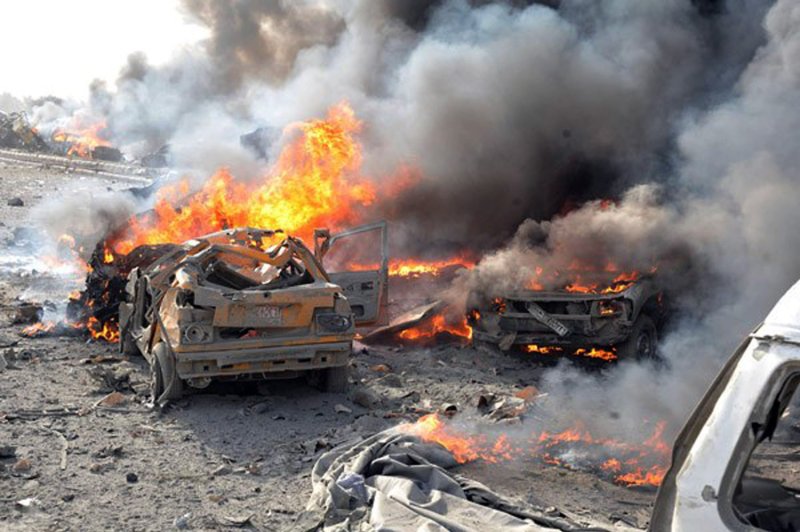A handout picture released by the Syrian Arab News Agency (SANA) shows burning vehicles at the site of twin suicide bomber blasts that killed 55 people in Damascus on May 10, 2012. Multiple suicide bombings in Homs and Damascus killed nearly 100 people on Sunday, according to activists and state news. UPI |
License Photo
DAMASCUS, Syria, Feb. 21 (UPI) -- Nearly 100 people are dead after multiple suicide bombings ripped through areas of two Syrian cities on Sunday, according to activists and state news.
The Syrian Observatory for Human Rights reported at least 46 people were killed and dozens more injured when two suicide car bombers detonated in the al-Zahraa neighborhood in the city of Homs.
At least 28 of the dead were civilians, though it was unclear whether the rest were Syrian soldiers or allied militiamen, the Britain-based monitoring group said.
Syria's state news agency, SANA, reported 45 people were killed and 100 injured in a coordinated attack that began with the detonation of a large car bomb near a school in the southern Damascus suburb of Sayyida Zeinab, followed by blasts from other suicide bombers inside crowds gathered at the scene.
The Islamic State claimed responsibility for the attack in Sayyida Zeinab, according to the BBC.
The bombings occurred in neighborhoods populated by religious groups considered heretical by the IS, also known as the ISIL, ISIS and Daesh. The al-Zahraa neighborhood is predominantly Alawite -- the sect to which President Bashar al-Assad belongs -- and Sayyida Zeinab is a mainly Shia Muslim community.
The IS also claimed responsibility for a late January suicide bombing at a Shia shrine in Sayyida Zeinab. The site reportedly contains the grave of one of the Prophet Muhammad's granddaughters and continues to draw many Shia pilgrims despite violence across Syria.
The bombings came as U.S. Secretary of State John Kerry announced a "provisional agreement in principal" with Russia for a temporary cease-fire in Syria. The pause would allow the delivery of humanitarian aid into besieged areas.
Kerry noted Moscow must enlist the support of the Assad government to implement the deal, while U.S. officials must persuade major opposition groups toward the same course.
However, a Russian-backed Syrian military offensive against rebel groups in Aleppo province has damaged negotiation efforts, causing the collapse of talks in Geneva earlier this month.
Opposition delegates with the Saudi-backed High Negotiations Committee said a temporary truce is only possible if Russia halts airstrikes against rebel forces -- a stipulation Moscow has rejected.
Likewise, Assad said he would only implement such a truce with guarantees that "terrorists" would not use the pause to improve their positions.















